WW1 FLAXTON ENLISTMENTS
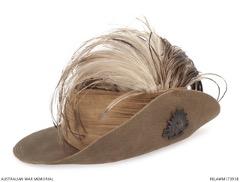
Slouch Hat with Emu feathers
(Courtesy Australian War Memorial)
Wilfred Bratton: Wilf enlisted in the First Australian Imperial Forces in 1916, aged 19 years. He served with 3rd Machine Gun Company and, like many of his fellow soldiers, suffered from the effects of gas warfare.
On his discharge, he returned to Flaxton and became a successful pineapple grower. He contributed a great deal to the local community and became well-known for his prowess at lawn bowls, for which he was honoured by being made a life member of the Nambour Bowls Club and patron of the Mapleton club. He was selected to play in Australia’s first international soccer (football) team when they went on a tour of New Zealand.
Wilf became a stalwart supporter of the Flaxton school and all the events associated with it. For many years, he fooled the young Flaxton kids into thinking he really was Santa Claus as he entertained them and handed out the gifts at the end-of-year Christmas tree.
George Skene: Aged just 18 years and 5 months, George enlisted in the A.I.F. in November 1917. He served with Rifles of the 31st Battalion on the battlefields of France. He spent some time in Graylingwell hospital in Chichester, England, before repatriation to Australia in 1919. His father and next of kin, William Skene, was one of the first settlers in Flaxton.
WW2 FLAXTON ENLISTMENTS: (Alphabetical order)
Les Banks: Les enjoyed the usual Flaxton send-off reserved for newly enlisted men and women in the armed forces. He joined the A.I.F in 1940.
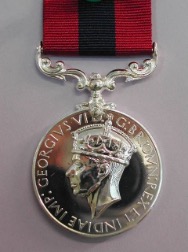
Distinguished Conduct medal
(Courtesy Gallantry Medallists League)
Clive Blair: Clive also enjoyed a send-off, Flaxton style, in Potts and McHaffie’s packing shed. Assigned to the 42nd Infantry Battalion, he and his fellow soldiers encountered some of the heaviest fighting against the Japanese invaders in New Guinea.
In an act of extreme gallantry, Clive attacked a Japanese stronghold and in so doing, allowed his troops to advance. This is one description of his gallantry: “Corporal Blair’s company commander, having been killed, Blair collected his men in the vicinity and pushed on to the attack. Later, when the platoon’s advance was held up by machine gun fire, he outflanked the enemy’s position, silenced it and returned to lead his men on. While endeavouring to silence a further machine gun he was wounded but continued to lead and only withdrew when his injury would not allow him to carry on.” Clive was awarded the Distinguished Conduct Medal, the only D.C.M. awarded to a member of the 42nd battalion. He spent a lengthy period recovering in hospital before returning to Flaxton.
Morris Dixon: Grandson of the Flaxton pioneer settler, Joseph Chapman Dixon, Morris joined the A.I.F. Engaged in active combat throughout the war, he rose to the rank of sergeant.
Ray Ensbey: Ray saw active service in Milne Bay and in New Guinea as a soldier in the A.I.F.
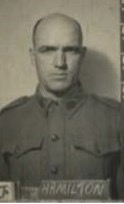
John Hamilton
John Hamilton: John deserves special mention. He served during WW2 in the A.I.F., having left his Flaxton farm to enlist at Toowoomba. On enlistment in 1941, he stated his year of birth as 1903, which would make him 38 years old. He was actually born in 1893 and was 48 years old. He had put his age back 10 years so he could meet the 40 years of age cut-off limit for enlistment. Record of his WW1 enlistment appear in the descriptions below.
Norman Mayne, who was married at the time, and despite having the sight of only one eye, was accepted into the Volunteer Defence Corps in 1942, aged 40 years. Promoted to Lance Corporal, he was placed in the reserves.
Gordon Mayne, the Flaxton general carrier, joined the R.A.A.F. in September, 1940. He achieved an 80.6% pass in his flight mechanic’s exam and served as an aircraftsman. He served at several locations until he received a transfer to Amberley, which made it easier for his wife and young daughter, Barbara, to visit.
Before enlisting, Gordon had appointed a driver to carry on his Flaxton carrying business for the duration of his military service. Due to health reasons, his driver resigned in 1943. The Manpower organisation deemed this business essential and recommended that Gordon be granted temporary release from service to continue as the Flaxton general carrier. Manpower later recommended his permanent release.
Gordon McKey: McKey, aged 18, enlisted firstly in the Volunteer Defence Corps then transferred to the R.A.A.F. in 1944, where he served as a flight rigger.
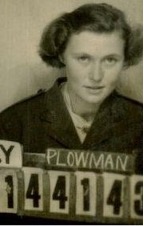
Patricia Plowman
Patricia Plowman: Pat joined the Australian Women’s Army Service and after completing her training in Sydney, served in the 21 Tele Operators Centre as a teleprinter operator. During her time in the AWAS, she met several like-minded servicewomen and they all remained friends for life. She also met a handsome airman whom she would later marry at the Methodist church in Montville. They had seven children together. When Pat passed away in 2011, two of her old AWAS companions attended her funeral to say their final farewells.

Volunteer Defence Corps insignia
Lachlan (Lacky) Robertson, born in Scotland in 1890 was 57 years and 3 months old when he joined the Volunteer Defence Corps, 6th. Battalion. The V.D.C., as it became generally known, took volunteers between the ages of 18 and 60, so Lacky made the cut by less than three years. The V.D.C. was modelled on the British Home Guard and they were trained in many forms of defence including sabotage, ready to go into action if Australia was invaded by an enemy, in this case, Japan. They filled an important role as observers and their catch-cry was, “Deny, Delay Protect.”
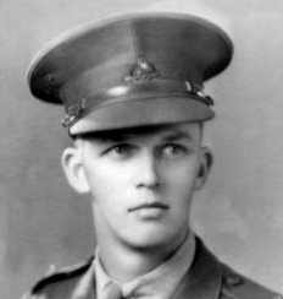
Major Jock Swain
John (Jock) Swain: Jock was seconded from his service with the Active Citizen Military Forces to the A.I.F. and retained his rank of Lieutenant. He was later promoted to Captain and then to the rank of Major with the Torres Strait Light Infantry Battalion. The only indigenous Australian battalion ever formed, they performed a garrison role defending the islands of the Torres Strait. Jock commanded the battalion for two years prior to his discharge on medical grounds.
*****
Flaxton remained for several decades as a small rural community. Considering its small population, it boasted a large number of returned servicemen and women among its residents. Although the following lists may be incomplete, they show the known WW1 and WW2 participants who did not enlist from Flaxton but who lived there in the 1920’s through to the 1940’s:
FLAXTON WW1 RETURNED SERVICEMEN WHO ENLISTED ELSEWHERE: (Alphabetical order)
Thomas (Tim) Clacy, joined the AIF in 1916, aged 25 years and 5 months and was assigned to the 49th. battalion He was married to Winifred and his years of service overseas must have been difficult for both of them.
Thomas (Roy) Copeland, gave his occupation as a farmer when he joined the AIF in July 1915, aged nineteen. Assigned to the 2nd. Light Horse and transferred to the 5th. Division in Egypt, he was appointed as a driver. He spent time in a London hospital suffering pneumonia. After active service in France, he was again hospitalised with appendicitis and trench fever.
Returning to Australia, he married Margorie and they had four boys all of whom attended the Flaxton primary school before continuing their education. Both Roy and Margorie supported the Flaxton community over many years
John Hamilton, Served in both WW1 and WW2. John served with the 11th Light Horse in WW1 and was among the Anzacs who fought at Gallipoli. He later won the Distinguished Conduct Medal while serving in Palestine. This official citation describes his valiant action:
“No. 767 Lance-corporal J.E. Hamilton, 11th Light horse regiment.
For conspicuous gallantry and devotion to duty.
He crawled about 60 yards forward towards the advancing enemy under heavy fire, got his machine gun into action, and held up the enemy’s advance, inflicting heavy casualties on them. He remained at his post for six hours regardless of the enemy’s fire, showing magnificent courage and determinant action.”
During his tour of duty, John’s father died and his mother became seriously ill. With no one left at home to provide for the young Hamilton family, applications were lodged to have him return home. The army, reluctant to release him, finally arranged for him to return to Australia in 1918.
Frank Hetherington, stated his occupation as a bank clerk when he signed up in March 1917. Assigned as a trooper to the 29th. Rifles, 5th. Light Horse, he experienced several bouts of illness whilst stationed in Suez. Worse was to come. In February 1919, he was hospitalised with malaria which plagued him for quite some time.
Frank married Doris and, like the Copelands, all their five children began their education at the Flaxton school. They both gave years of service to the school and to the Flaxton community.
Frank had mandarin orchards and also ran a few cattle. At times he worked at the Flaxton sawmill.
David McHaffie, assigned to the 2nd. Light Horse, Joined the AIF in 1916, aged 26 years, his occupation, Presbyterian Clergyman. Surprisingly, perhaps, he was not used in this capacity and was transferred to the 8th Sanitary Section. On arrival in Egypt, he took up duties at the Australian Isolation Camp at Moascar.
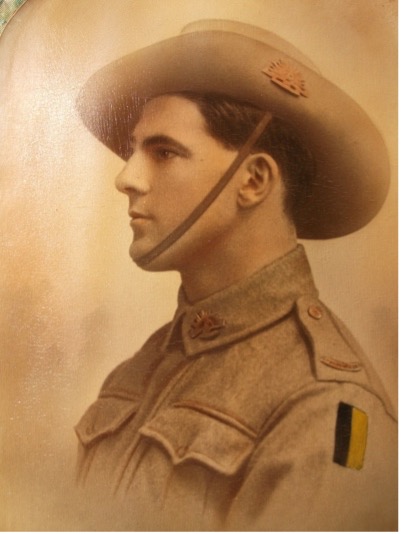
Ray Plowman wearing colour patch of 29th Btn
Ray Plowman began his overseas service with the 29th battalion as a reinforcement in July, 1916, aged 19 years and 7 months. He suffered a gunshot wound to his right arm at the battle of Polygon Wood in Belgium and was sent for medical attention to hospital in Bristol, England. Below is the story he told about his stay there:
“During the Great War, Aussies and Poms shared a grudging respect for each other. Wounded in Polygon Wood, Ray Plowman lay recovering in hospital in Bristol. He and his fellow patients watched as the fruit of a quince tree in the hospital yard gradually ripened. They conspired to raid the tree. One of the recovering patients tucked a pillow-slip under his pyjamas and sneaked out. To everyone’s dismay, he returned empty handed. Someone had been there before him.
Next day a nurse came in carrying a large bag. Inside were eight quinces and a note which read: “Your share. From the Pommie bastards in ward 4C.”
Ray married Edith and they bought a dairy farm in Flaxton. Later, Ray and partners established the Flaxton sawmill on Mill Road. All four of their children attended the Flaxton school.
With WW1 returned soldiers Ray Plowman, Roy Copeland and Frank Hetherington all working at the sawmill, it became a kind of unofficial meeting place for returned servicemen whose bond of camaraderie remained unbreakably strong.

Frank (Wal) Potts
Frank (Wal) Potts, a tailor by trade, signed up in 1916, aged 27 years and 9 months. From Sydney he transferred to Suez where he was assigned to the 8th. Sanitary section. In retrospect, this was a stroke of good fortune because it was here that he met David McHaffie and they became lifelong friends.
After the war, Wal Potts and David McHaffie bought a farm together in Flaxton where they grew pineapples. These two men became Flaxton icons, always involved with the community and ever ready to help a good cause.
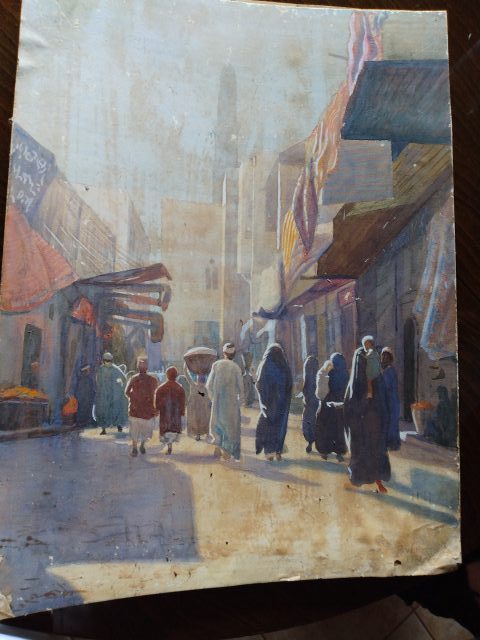
Streets of Cairo, 1921 painted by Wal Potts
Wal was both a musician and a painter. He is now considered as one of Queensland’s outstanding still-life artists. The Queensland Art Gallery possess two of his landscapes.
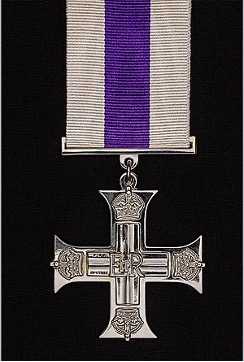
Military Cross
George Still, a draftsman in the public service, had previous military experience when he enlisted in May, 1915. With six years in school cadets and two years in Field Artillery in Brisbane, he was assigned as a reinforcement to the 31stbattalion. He was aged 32 years and 10 months and was married.
He attained the rank of Lieutenant in 1916 and was awarded the Military Cross for conspicuous gallantry in action (France): “He rallied and organised straggling troops and led them over open country. During the night in the enemy’s main breastwork he ably assisted in consolidating the position won.”
Due to ongoing eye problems, George was discharged in 1917. He and his wife took up farming in Flaxton where they both served the local community and the fruit growers organisations for many years.
*****
FLAXTON WW2 RETURNED SERVICEMEN WHO ENLISTED ELSEWHERE:
Doug Cogill, lived at the ‘Mapleton end’ of Flaxton and hailed from a Mapleton family whose war service record had few parallels. Let the Nambour Chronicle, 26th October 1945 tell the story: “…Both speakers referred to the wonderful war record of the Cogill family.
“Mr. G Cogill Snr. has seen service in two wars. His five sons were in the services, one having won a decoration; his three daughters all having donned a uniform.”
Son, John Cogill, was awarded the Distinguished Conduct Medal.
Daughters Eva and Marion joined the A.W.A.S. and their sister, Violet, served in the W.A.A.F.
Thomas (Tommy) Rattle, born in Bristol, England, enlisted in the AIF in Brisbane in August 1941, aged 33 years and 9 months. He was married and gave his occupation as a labourer. He joined the 2/5 Aust. Armed Regiment and was assigned to the cooking and catering service as a cook. He served 1,300 days in service in various locations in Australia at which time his address was given as, Montville via Palmwoods. On discharge he took up dairy farming in Flaxton.
Adolph Schmidt, a married timber worker when he enlisted in 1940, aged 34, was assigned to the 2/32 Infantry Battalion. His war record shows that he served in Australia, and overseas including at Milne Bay. He received a gunshot wound to his left leg in 1942 and endured an extended period with chronic bronchitis. He was discharged from duties near the end of 1943. His military service record shows that he served 238 days in Australia and 1,027 days overseas.
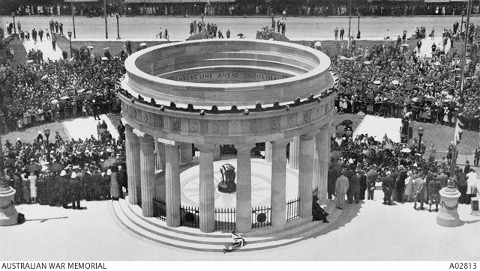
Eternal Flame war memorial, Brisbane
(Courtesy Australian War Memorial)
(Researched and Written by Gordon Plowman, March 2022)

 ©2016 Montville History Group. All rights reserved.
©2016 Montville History Group. All rights reserved.